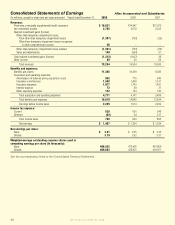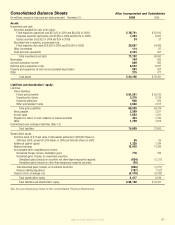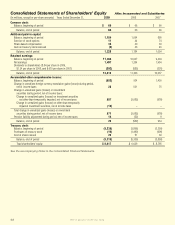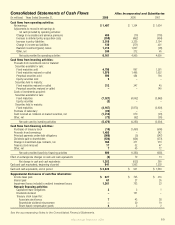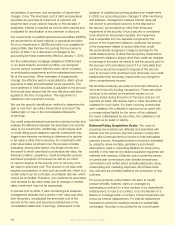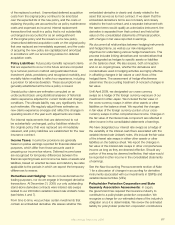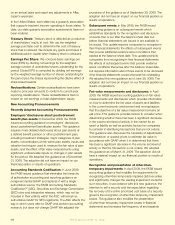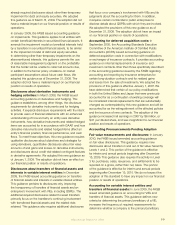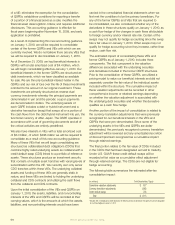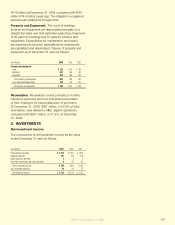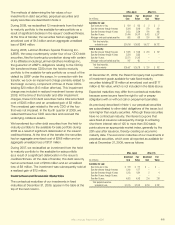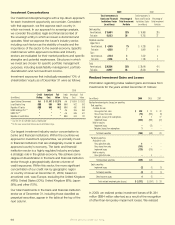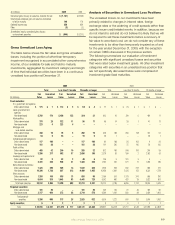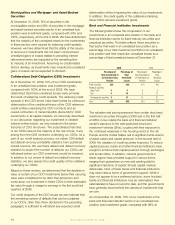Aflac 2009 Annual Report Download - page 64
Download and view the complete annual report
Please find page 64 of the 2009 Aflac annual report below. You can navigate through the pages in the report by either clicking on the pages listed below, or by using the keyword search tool below to find specific information within the annual report.
of a VIE; eliminates the exemption for the consolidation
of QSPEs; establishes conditions for reporting a transfer
of a portion of a nancial asset as a sale; modies the
nancial asset derecognition criteria; and requires additional
disclosures. This accounting guidance is effective for
scal years beginning after November 15, 2009, and early
application is prohibited.
As a result of implementing this new accounting guidance
on January 1, 2010, we will be required to consolidate
certain of the former QSPEs and VIEs with which we are
currently involved. We do not believe there are any VIEs that
we will be required to deconsolidate on January 1, 2010.
As of December 31, 2009, we had benecial interests in
QSPEs with a total amortized cost of $4.4 billion, which
we will begin consolidating effective January 1, 2010. Our
benecial interests in the former QSPEs are structured as
debt investments, which we have classied as available
for sale. We are the only benecial interest holder in the
QSPEs and our risk of loss over the life of these investments
is limited to the amount of our original investment. These
investments are primarily structured as reverse dual-
currency investments whereby the principal payments are
denominated in yen and the periodic coupon payments
are denominated in dollars. The underlying assets of
each QSPE includes a debt or hybrid instrument and a
derivative transaction (swap) that swaps all or a portion of
the cash ows from the debt/hybrid instrument into yen, the
functional currency of Aac Japan. The QSPE operates in
accordance with a set of governing documents and all of
the critical activities are entirely predened.
We also have interests in VIEs with a total amortized cost
of $3.0 billion, of which $496 million we will be required to
consolidate as a result of this new accounting guidance.
Many of these VIEs that we will begin consolidating are
structured as collateralized debt obligations (CDOs) that
combine highly rated underlying assets as collateral with a
credit default swap (CDS) linked to a portfolio of reference
assets. These structures produce an investment security
that consists of multiple asset tranches with varying levels of
subordination within the VIE. We currently own only senior
CDO tranches within these VIEs. The underlying collateral
assets and funding of these VIEs are generally static in
nature, and these VIEs are limited to holding the underlying
collateral and CDS contracts and utilizing the cash ows
from the collateral and CDS contracts.
Upon the initial consolidation of the VIEs and QSPEs on
January 1, 2010, the assets, liabilities, and noncontrolling
interests of the VIEs and QSPEs will be recorded at their
carrying values, which is the amounts at which the assets,
liabilities, and noncontrolling interests would have been
carried in the consolidated nancial statements when we
rst met the conditions to be the primary beneciary. For
any of the former QSPEs and VIEs that are required to
be consolidated, we also considered whether any of the
derivatives in these structures qualify on January 1, 2010, as
a cash ow hedge of the changes in cash ows attributable
to foreign currency and/or interest rate risk. Certain of the
swaps may not qualify for hedge accounting since the swap
has a fair value on January 1, 2010. Other swaps may not
qualify for hedge accounting since they increase, rather than
reduce, cash ow risk.
The estimated impact of consolidating these VIEs and
former QSPEs as of January 1, 2010, includes three
components. The rst component is the valuation
differences associated with the underlying securities
and derivatives included in the former QSPE structures.
Prior to the consolidation of these QSPEs, we utilized a
pricing model to value our benecial interests and did not
separately consider the fair value of the individual assets
included within the structure. The cumulative impact of
these valuation adjustments will be recorded in other
comprehensive income or retained earnings depending
on whether the valuation adjustment is associated with
the underlying debt securities and whether the derivative
qualies as a cash ow hedge.
Another portion of the impact of consolidation is related to
the currency translation adjustments that were previously
recognized for our benecial interests in the VIEs and
QSPEs that were yen-denominated. Since some of the
underlying assets in the VIEs and QSPEs are dollar-
denominated, the previously recognized currency translation
adjustment will be reversed and any amortization/accretion
of discount/premium recognized as a cumulative impact
through retained earnings.
The nal portion relates to the fair value of CDSs included
in the CDOs that had been designated as held to maturity.
Under U.S. GAAP, these credit default swaps will be
recorded at fair value as a cumulative effect adjustment
through retained earnings. The CDSs are not eligible for
hedge accounting.
The following table summarizes the estimated after-tax
consolidation impact:
(In millions) Total Shareholders’ Equity
Cumulative valuation adjustments $ 157*
Currency translation adjustments (295)
Credit default swaps (73)
Total $ (211)
* Includes $54 in realized gains which represents the effective portion of derivatives that qualify for and are designated
as cash flow hedges on January 1, 2010
We’ve got you under our wing.
60


